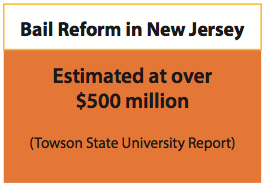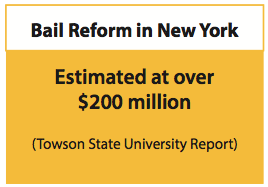EFFECTIVENESS AND COST
Two important benefits of surety bail are its effectiveness and the fact that it operates at no cost to the counties and communities it serves. In fact, the surety bail industry is responsible for guaranteeing to the courts over $16 Billion in liability along with the management and supervision of over 2,000,000 defendants released each year.
There have been a multitude of academic, government and private studies done on the topic of pretrial release. Each and every study done has shown similar results. When it comes to guaranteeing appearance at court, surety bail outperforms every form of public sector pretrial release and own recognizance release as well.
Beyond its effectiveness, one of the most compelling aspects of surety bail is that it not only lacks direct costs to local governments but because it helps mitigate costs to the system when defendants fail to appear. In fact, in rare cases where defendants don’t show up for court, because their release was financially guaranteed through a surety bond, the courts and communities are compensated for the full amount of the bond. Additionally, bail agents pay premium taxes to the state/county for each bond they write. So by providing a $0 operational cost benefit to the community, along with a positive cash flow potential through premium taxes, licensing fees and forfeiture payments, surety bail is one of the smartest and most cost effective tools for counties to utilize in their criminal justice systems.
Another way to look at the cost savings that surety bail provides to a community is by looking at the costs of the alternative methods of release. In 2013, Dr. Robert Morris of the University of Texas at Dallas conducted a study of ALL pretrial releases in Dallas, Texas over a year period. In his analysis he determined that when a defendant missed a court date, that there was a cost to the county for all the resources that were put in place for that case that now have gone to waste. That cost was determined to be $1,775 per defendant each time they failed to appear. Based on that conclusion and based on the failure to appear rates calculated in the study, Dr. Morris found that the surety bail industry saved Dallas County over $11 million by getting defendants to court.
One of the many arguments used by proponents of Bail Reform has been around the cost savings provided by alternative release mechanisms.
Bail reform efforts often lead to drastic changes in the processing of criminal defendants. Due to additional procedures and steps necessary for law enforcement under these types of reforms, officers are routinely kept off the streets and tied to their desk for hours processing just one defendant. County budgets are impacted with additional mandatory court hours, additional judges, a robust pretrial services division, monitoring equipment purchases and maintenance, and the list goes on.
In fact, counties in New Jersey led a lawsuit claiming an “unfunded mandate” after bail reform began in January of 2017, only to lose by a technicality and not on the merits of the case. The counties claimed that bail reform would cost millions to implement, and it did. In just one year, the New Jersey judiciary has stated that the courts will run out of money to fund the program and must need millions in additional taxpayer money. This, despite 2 years of planning and $130 Million in reserves to begin the program.
There“really is no “jail bed” savings calculation that can be attributed to eliminating “money bail.”
Proponents have long claimed that by eliminating “money bail” and implementing a robust pretrial services agency, a county can save millions of dollars. They calculate this figure by taking the total cost of a jail, dividing it by the number of days in a year, and then dividing it by the number inmates in a day. Far from scientific, this simple calculation is supposed to represent a day cost per jail bed. Every person they release for free can then be multiplied by the cost per jail bed and you have your savings.
The problem with this type of calculation is that most of jail costs aren’t variable, but rather they are fixed. Letting one person out of jail does not save money because costs are not based on occupancy in that way. The corrections officers must still be paid, housing costs for the facility must still be paid, and the food must still be bought. It costs the same to guard a 1⁄2 empty jail pod as it does a fully occupied jail pod – minus a few meals. The only way you save money in a jail is by closing a wing or an entire jail, which rarely happens under reform efforts due to most jails operating at near capacity already.
Another fault in this type of cost analysis is that jail population numbers are not constant. They are making the false assumption that if someone is let out of jail, the bed they are removing him from is now empty and they have no “bed cost,” thus a savings. Once again, the reality of this scenario simply doesn’t add up. Jail populations are not static, they are very much fluid. If a jail bed is freed up, it is not left empty but rather filled up by another inmate. As you can see, there“really is no “jail bed” savings calculation that can be attributed to eliminating “money bail.”
In the process of explaining to people how much money the pretrial programs can save (which of course, they don’t), proponents rarely talk about how much these pretrial programs cost – perhaps for obvious reasons.

Other states have done costs analysis of pretrial programs and economists have reported their findings on potential costs to implement the no-money bail system.
Reforming the bail system in any jurisdiction will only happen at great cost to taxpayers and cannot be dismissed – especially when these proposed reforms have unintended consequences that threaten public safety and criminal accountability.
Regardless as to the degree any proposed changes to the bail system a jurisdiction is legislatively willing to go, it is incumbent upon lawmakers and stakeholders to understand the social impact to the communities they serve.








